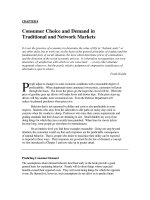Chapter 8 Main memory
Bạn đang xem bản rút gọn của tài liệu. Xem và tải ngay bản đầy đủ của tài liệu tại đây (997.98 KB, 57 trang )
Chapter 8: Main Memory
Chapter 8: Main Memory
8.2
Silberschatz, Galvin and Gagne ©2005
Operating System Concepts – 7
th
Edition, Feb 22, 2005
Chapter 8: Memory Management
Chapter 8: Memory Management
■
Background
■
Swapping
■
Contiguous Memory Allocation
■
Paging
■
Structure of the Page Table
■
Segmentation
■
Example: The Intel Pentium
8.3
Silberschatz, Galvin and Gagne ©2005
Operating System Concepts – 7
th
Edition, Feb 22, 2005
Objectives
Objectives
■
To provide a detailed description of various ways of
organizing memory hardware
■
To discuss various memory-management techniques,
including paging and segmentation
■
To provide a detailed description of the Intel Pentium, which
supports both pure segmentation and segmentation with
paging
8.4
Silberschatz, Galvin and Gagne ©2005
Operating System Concepts – 7
th
Edition, Feb 22, 2005
Background
Background
■
Program must be brought (from disk) into memory and placed
within a process for it to be run
■
Main memory and registers are only storage CPU can access
directly
■
Register access in one CPU clock (or less)
■
Main memory can take many cycles
■
Cache sits between main memory and CPU registers
■
Protection of memory required to ensure correct operation
8.5
Silberschatz, Galvin and Gagne ©2005
Operating System Concepts – 7
th
Edition, Feb 22, 2005
Base and Limit Registers
Base and Limit Registers
■
A pair of base and limit registers define the logical address space
8.6
Silberschatz, Galvin and Gagne ©2005
Operating System Concepts – 7
th
Edition, Feb 22, 2005
Binding of Instructions and Data to Memory
Binding of Instructions and Data to Memory
■
Address binding of instructions and data to memory addresses
can happen at three different stages
●
Compile time: If memory location known a priori, absolute code
can be generated; must recompile code if starting location changes
●
Load time: Must generate relocatable code if memory location is
not known at compile time
●
Execution time: Binding delayed until run time if the process can
be moved during its execution from one memory segment to
another. Need hardware support for address maps (e.g., base and
limit registers)
8.7
Silberschatz, Galvin and Gagne ©2005
Operating System Concepts – 7
th
Edition, Feb 22, 2005
Multistep Processing of a User Program
Multistep Processing of a User Program
8.8
Silberschatz, Galvin and Gagne ©2005
Operating System Concepts – 7
th
Edition, Feb 22, 2005
Logical vs. Physical Address Space
Logical vs. Physical Address Space
■
The concept of a logical address space that is bound to a
separate physical address space is central to proper memory
management
●
Logical address – generated by the CPU; also referred to as
virtual address
●
Physical address – address seen by the memory unit
■
Logical and physical addresses are the same in compile-time
and load-time address-binding schemes; logical (virtual) and
physical addresses differ in execution-time address-binding
scheme
8.9
Silberschatz, Galvin and Gagne ©2005
Operating System Concepts – 7
th
Edition, Feb 22, 2005
Memory-Management Unit (
Memory-Management Unit (
MMU
MMU
)
)
■
Hardware device that maps virtual to physical address
■
In MMU scheme, the value in the relocation register is added to
every address generated by a user process at the time it is sent to
memory
■
The user program deals with logical addresses; it never sees the real
physical addresses
8.10
Silberschatz, Galvin and Gagne ©2005
Operating System Concepts – 7
th
Edition, Feb 22, 2005
Dynamic relocation using a relocation register
Dynamic relocation using a relocation register
8.11
Silberschatz, Galvin and Gagne ©2005
Operating System Concepts – 7
th
Edition, Feb 22, 2005
Dynamic Loading
Dynamic Loading
■
Routine is not loaded until it is called
■
Better memory-space utilization; unused routine is never loaded
■
Useful when large amounts of code are needed to handle
infrequently occurring cases
■
No special support from the operating system is required
implemented through program design
8.12
Silberschatz, Galvin and Gagne ©2005
Operating System Concepts – 7
th
Edition, Feb 22, 2005
Dynamic Linking
Dynamic Linking
■
Linking postponed until execution time
■
Small piece of code, stub, used to locate the appropriate
memory-resident library routine
■
Stub replaces itself with the address of the routine, and
executes the routine
■
Operating system needed to check if routine is in processes’
memory address
■
Dynamic linking is particularly useful for libraries
■
System also known as shared libraries
8.13
Silberschatz, Galvin and Gagne ©2005
Operating System Concepts – 7
th
Edition, Feb 22, 2005
Swapping
Swapping
■
A process can be swapped temporarily out of memory to a backing store,
and then brought back into memory for continued execution
■
Backing store – fast disk large enough to accommodate copies of all
memory images for all users; must provide direct access to these memory
images
■
Roll out, roll in – swapping variant used for priority-based scheduling
algorithms; lower-priority process is swapped out so higher-priority process
can be loaded and executed
■
Major part of swap time is transfer time; total transfer time is directly
proportional to the amount of memory swapped
■
Modified versions of swapping are found on many systems (i.e., UNIX,
Linux, and Windows)
■
System maintains a ready queue of ready-to-run processes which have
memory images on disk
8.14
Silberschatz, Galvin and Gagne ©2005
Operating System Concepts – 7
th
Edition, Feb 22, 2005
Schematic View of Swapping
Schematic View of Swapping
8.15
Silberschatz, Galvin and Gagne ©2005
Operating System Concepts – 7
th
Edition, Feb 22, 2005
Contiguous Allocation
Contiguous Allocation
■
Main memory usually into two partitions:
●
Resident operating system, usually held in low memory with
interrupt vector
●
User processes then held in high memory
■
Relocation registers used to protect user processes from each
other, and from changing operating-system code and data
●
Base register contains value of smallest physical address
●
Limit register contains range of logical addresses – each logical
address must be less than the limit register
●
MMU maps logical address dynamically
8.16
Silberschatz, Galvin and Gagne ©2005
Operating System Concepts – 7
th
Edition, Feb 22, 2005
HW address protection with base and limit registers
HW address protection with base and limit registers
8.17
Silberschatz, Galvin and Gagne ©2005
Operating System Concepts – 7
th
Edition, Feb 22, 2005
Contiguous Allocation (Cont.)
Contiguous Allocation (Cont.)
■
Multiple-partition allocation
●
Hole – block of available memory; holes of various size are scattered
throughout memory
●
When a process arrives, it is allocated memory from a hole large
enough to accommodate it
●
Operating system maintains information about:
a) allocated partitions b) free partitions (hole)
OS
process 5
process 8
process 2
OS
process 5
process 2
OS
process 5
process 2
OS
process 5
process 9
process 2
process 9
process 10
8.18
Silberschatz, Galvin and Gagne ©2005
Operating System Concepts – 7
th
Edition, Feb 22, 2005
Dynamic Storage-Allocation Problem
Dynamic Storage-Allocation Problem
■
First-fit: Allocate the first hole that is big enough
■
Best-fit: Allocate the smallest hole that is big enough; must
search entire list, unless ordered by size
●
Produces the smallest leftover hole
■
Worst-fit: Allocate the largest hole; must also search entire
list
●
Produces the largest leftover hole
How to satisfy a request of size n from a list of free holes
First-fit and best-fit better than worst-fit in terms of
speed and storage utilization
8.19
Silberschatz, Galvin and Gagne ©2005
Operating System Concepts – 7
th
Edition, Feb 22, 2005
Fragmentation
Fragmentation
■
External Fragmentation – total memory space exists to satisfy a
request, but it is not contiguous
■
Internal Fragmentation – allocated memory may be slightly larger
than requested memory; this size difference is memory internal to a
partition, but not being used
■
Reduce external fragmentation by compaction
●
Shuffle memory contents to place all free memory together in one large
block
●
Compaction is possible only if relocation is dynamic, and is done at
execution time
●
I/O problem
Latch job in memory while it is involved in I/O
Do I/O only into OS buffers
8.20
Silberschatz, Galvin and Gagne ©2005
Operating System Concepts – 7
th
Edition, Feb 22, 2005
Paging
Paging
■
Logical address space of a process can be noncontiguous;
process is allocated physical memory whenever the latter is
available
■
Divide physical memory into fixed-sized blocks called frames
(size is power of 2, between 512 bytes and 8,192 bytes)
■
Divide logical memory into blocks of same size called pages
■
Keep track of all free frames
■
To run a program of size n pages, need to find n free frames
and load program
■
Set up a page table to translate logical to physical addresses
■
Internal fragmentation
8.21
Silberschatz, Galvin and Gagne ©2005
Operating System Concepts – 7
th
Edition, Feb 22, 2005
Address Translation Scheme
Address Translation Scheme
■
Address generated by CPU is divided into:
●
Page number (p) – used as an index into a page table which
contains base address of each page in physical memory
●
Page offset (d) – combined with base address to define the
physical memory address that is sent to the memory unit
●
For given logical address space 2
m
and page size
2
n
page number
page offset
p
d
m - n
n
8.22
Silberschatz, Galvin and Gagne ©2005
Operating System Concepts – 7
th
Edition, Feb 22, 2005
Paging Hardware
Paging Hardware
8.23
Silberschatz, Galvin and Gagne ©2005
Operating System Concepts – 7
th
Edition, Feb 22, 2005
Paging Model of Logical and Physical Memory
Paging Model of Logical and Physical Memory
8.24
Silberschatz, Galvin and Gagne ©2005
Operating System Concepts – 7
th
Edition, Feb 22, 2005
Paging Example
Paging Example
32-byte memory and 4-byte pages
8.25
Silberschatz, Galvin and Gagne ©2005
Operating System Concepts – 7
th
Edition, Feb 22, 2005
Free Frames
Free Frames
Before allocation
After allocation









